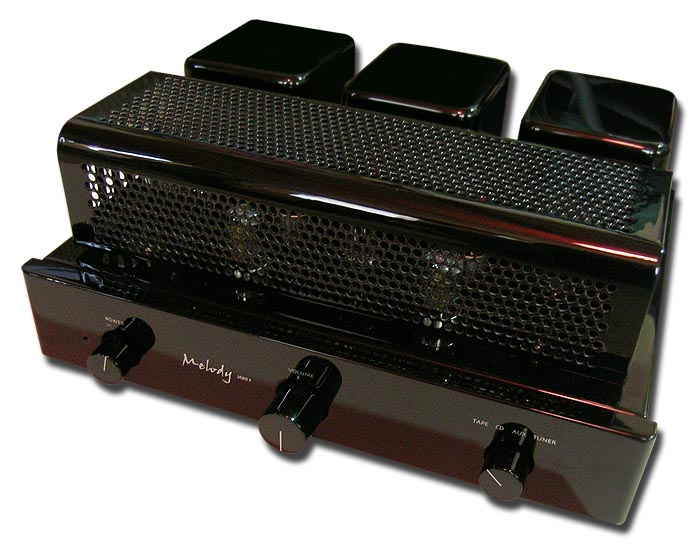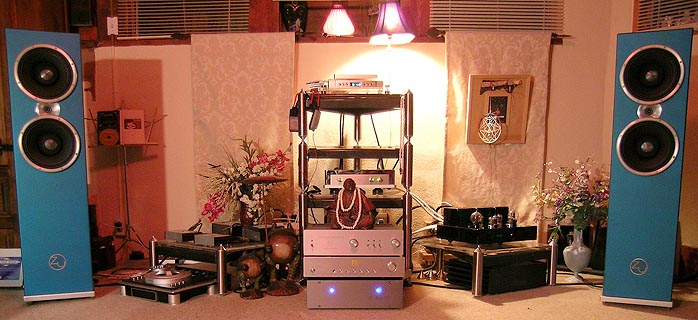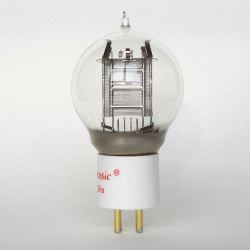|
This review page is supported in part by the sponsor whose ad is displayed above
|
|||||||||||||||
 |
|||||||||||||||
| Compared to my Goliath-slaying and suitably puny Music First Passive Magnetic, the Melody preamp -- true to a far smaller extent also for the ModWright and Hyperion pieces -- operates on a lower level of resolving power. It's an area where this TVC is possibly as good as it gets. "Lower" means a few discrete clicks shy of the ultimate as epitomized by premium transformer attenuation sans active circuitry. Mind you, without hearing the passive, you'd likely not identify the 1688 as falling anywhere short of rez. It's only in a direct A/B with the Stevens & Billington fitted TVC that you appreciate, again, how the endless game of tradeoffs remains stubbornly at work even at this level. In exchange for its condensed image density and deeper color temperature, the Melody sacrifices transparency and microdynamic spunk. It's softer and more relaxed but also comparatively veiled. That's brutally apparent at lower playback levels but remains the case at regular SPLs when you come off the MF. (And yes, those initials are shared by another UK brand we'll shortly look into. In coarse slang, these initials stand for something else again. It's fitting when used by the competition trying to recover from being compared to the Music First). I suspect the octal tubes on the Melody's deck as primary reason for its slightly taffy-like mien. It rounds over transient brio and inserts a bit of air lock distance between listener and musicians. Coffee with lotsa milk. It took me a while to forget my passive reference and stop quietly complaining. Conversely, the burden of tonal sophistication and dimensional persuasiveness when using a passive even of the caliber of the Music First now rests squarely on the source/amp combination. It becomes primarily the amp which you hear. And that demands perfection, on its own, without the collaborative interaction between preamp and amp. Personally -- and with amps like the Yamamoto A-08S and First Watt F3 -- I distinctly prefer the passive over the Melody for its far greater immediacy and ability to resolve data. It's the sense that you're closer to the pumping sloshing heart of musical rawness instead of dealing with a somewhat idealized, tamer and prettified version thereof. The second minor weakness of the 1688 -- surprisingly, I might add -- is its looser grip and lesser weight in the bass. This was very apparent on my Definition Pros whose performance in the bottom was clearly in a different league with the passive. This nearly doesn't sound right in the saying especially considering the mondo power supply of the Melody. Still, it's what I heard. It was repeatable too. Perhaps tube rolling the Melody could optimize this aspect but I went with what was supplied. Sean Casey of Zu together with Adam Decaria has amassed quite the hardware arsenal including Audiopax Model 88s and a 1688. He reports that on the Brazilian amps, the Melody is by far his favorite preamp. On other Zu-owned amplifiers, the 1688 gets trumped. This suggests that -- as with most things audiophile -- copaseticity between components remains an important consideration. |
|||||||||||||||
 |
|||||||||||||||
| Of greatest personal interest in assessing the Melody's mettle was the fortuitous presence of the ModWright SWL 9.0SE and Hyperion Sound BEC-P25T in Taos, two serious tube-powered contenders for high-level sonics at realistic pricing. To avoid compounding valve effects, I first ran the solid-state Power JFET amplifier by Nelson Pass for these particular comparisons rather than the Yamamoto. While both amps are veritable stand-ins for one another, they're not perfectly identical. The Yamamoto enjoys a slight edge in the tone department and is an ideal candidate for TVCs. How would the Melody distinguish itself from the other two valved pieces when running into the F3? |
|||||||||||||||
 |
|||||||||||||||
To begin with, the lo-gain outputs are truly silent even on 101dB noise trackers for speakers. That's always a prospective concern with tubed preamps, especially those with significant gain. The fact that the Melody is stone quiet is a testament to very competent engineering. The provision of non-switched hi/lo output sockets -- and a very generous two pairs per channel -- is plain considerate and user-friendly and allows for biamping and dual-mono subbing all at once. |
|||||||||||||||
 |
|||||||||||||||
The 1688's tall transformers meant that it didn't fit into the Monaco rack. It had to be housed on its own amp stand instead. If you purchase this preamp, plan on top shelf placement or 10 inches of clearances. And now to sonics. I must confess that the concept of the 1688 -- appearance, the exotic globe tubes, the immaculate build quality, price and top-notch parts -- eclipsed listener satisfaction. While there was nothing wrong with the Melody on its own, it rather suffered at the hands of A/B comparisons. Both the ModWright and Hyperion Sound preamps are more energetic and transcend the minor lethargy I hear with the 1688. Both resolve more micro nuances on superior recorded fare like Todd Garfinkle's newest CD/SACD sampler that's been released in conjunction with Crystal Cable and is simply dubbed MA on SA. Try as I might, I could never quite get over the cotton candy distance and minor stickiness whereby the 1688 didn't let go of the notes as rapidly and unattached as I'm accustomed to nor rendered them as crisply and fast on the leading edge. |
|||||||||||||||
 |
|||||||||||||||
| I rather felt like how I imagine our Jeff Day feels now that he's plunked down hard cash on the Tom Evans Design Vibe 7. Once you hear a truly exalted level of resolution that's presented organically rather than clinically, returning to the cloud cover of minor romance curiously lacks the appeal it might have held before you broke through to the higher plateau. Considering the acclaim the 1688 II enjoys reportedly in the Far East -- where we know listeners to be exceptionally astute --, I'm somewhat suspicious that tube rolling experiments would be in order to prevent premature judgment on my part. Alas, I don't hoard any octals. |
|||||||||||||||
 |
To overcome writer's block -- the near automatic writing of enthusiasm turned to clutched grind -- I decided to insert the Genesis M60s. Those are not only higher power but very gutsy-sounding push/pull devices. Aloha! If you forgive a worn-out cliché, this move seemed like upgrading to a V8. The new ride's greater drive -- 60 watts on paper are complete overkill on 101dB speakers -- and softer suspension rode over my previous complaints with far less passenger jarring if you will. Sure, reverting to the other preamps -- especially the passive -- could still revisit the earlier impressions; but to a lesser extent as though the amps' greater drive acted somewhat like an equalizer. More importantly, the | ||||||||||||||
| presentation on its own now had considerable merit. As my review of the Genesis monos reported, they're high-resolution designs. They present music with enormous scale and elan. If the last bit of ultimate detail and incisiveness fell by the wayside with the Melody in the chain, awareness thereof was essentially obliterated now. I could finally get into digging the globe machine for what it did rather than what it didn't. Perhaps because of its four octals, the Melody does enormous space with a bit of whipped-cream fluffiness. Where that innate relaxation and laid-back vibe was clearly overdone with my SETs, those attributes blended just fine into the muscular presentation of the Genesis monos. I don't want to generalize but prospective 1688 users may want to stick to push/pull amps to hear their boffo new preamp at its best. |
|||||||||||||||
| Better bass is another reason for this suggestion. Why and how a passive could be clearly superior in this regard is beyond me but the same held true for the other two valved preamps. Nevertheless, the bass-happy KT88 amps were little restrained by the Melody's shyness in this regard and the combined result left nothing to be desired. Mind you, I'm a guy who listens to eight 10-inch woofers which are additionally EQ'd to be a measured 3dB up at 20Hz. My "bass visibility" is so keen that any losses telegraph directly and clearly. Someone else with a lesser obsession over infrasonics might well not be as critical. That's why it's important to remember that reviews are nothing but opinions - educated opinions, one hopes, and consistently measured with the same yard stick but personal opinions nonetheless. |
|||||||||||||||
 |
|||||||||||||||
| It also depends on your primary musical focus. Anything that lives and dies on tone and space will be perfect for the Melody. Grittiness, slam and high-revving drive won't come across completely uncut and seem a bit rounded | |||||||||||||||
| over and civilized - which, again, could be just what the doctor ordered especially if you suffer from forward, bright and spitty speakers. Naturally, cable tweaking can further emphasize or defocus those qualities. The Melody 1688 II does not seem to suffer any overt nonlinearities below 80Hz, i.e. whatever treble roll-off (or not) may be the case would have to occur beyond my 17kHz hearing limit. In conclusion, I must apologize for what to me seems a somewhat incomplete review. It's incomplete not only because I suspect that I never got to hear this piece at its best, it's incomplete also because I'm not even sure what the 1688 II retails for in the US. While it's true that the US High-End audio market at present is incredibly fragmented and oversaturated, Mr. Wang of Melody would still be well served to control his distribution over here better than suffer China-direct grey market importation and no proper documentation on the brand. One thing is beyond doubt: the build quality of Melody (I've now experienced it with the SP3, Genesis monos and the 1688) is truly superlative and a poster child for what other companies should aspire to! |
|||||||||||||||
 |
|||||||||||||||
 |
|||||||||||||||
|
Manufacturer's website
|
|||||||||||||||
 |
|||||||||||||||